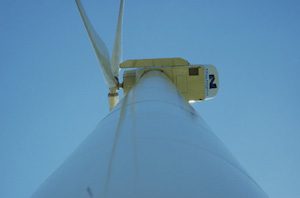Wind turbine operators are under tremendous pressure to minimize maintenance costs and maximize turbine availability in order to protect profits. A vibration monitoring strategy can help engineers can establish a robust preventative maintenance regime and boost reliability.
Globally, there were roughly 340,000 wind turbines spinning at the end of 2016 (up from 225,000 five years earlier). These turbines represent a combined capacity of more 430 gigawatts (GW). With a 25 percent compound annual growth rate, and increased spending expected worldwide for the foreseeable future, cumulative capacity could be as high as 175,000 GW by 2030.
Wind farms are also getting bigger. The largest wind farm in North America, Alta Wind Energy Center in California, which is the third largest in the world, will be small in comparison with the proposed 3-GW Chokecherry-Sierra Madre Wind Project in the U.S. or the proposed expansion of China’s 6-GW Gansu wind farm to a staggering 20-GW by 2020.
With all of these turbines in the ground and even more coming online soon, operations and maintenance (O&M) is a major growth area in the wind industry. In addition, a host of engineering problems, such as short-circuits and failures due to excessive friction, lightning strikes, storms and other issues have made maintenance a growing concern for plant operators.
Naturally, optimizing the technology to maximize efficiency and keep downtime to a minimum is a priority for all wind farm stakeholders. In an ideal world, components would never fail, turbines would always spin and electricity sales would never be interrupted. However, reducing the number of machine failures and stoppages is not and easy task. The demands placed on key equipment such as gearboxes or hydraulic systems are very rigorous and therefore it is these components that trigger the most serious and sometime catastrophic issues in wind turbines.
Solar Energy in South Carolina
More Americans are taking advantage of the substantial and various benefits installing a residential solar energy system can provide – and not just because the federal solar investment tax credit is winding down. Utilities in states across the nation are ramping up their investments in solar power generation as well, but they continue to lobby for rules and regulations that maintain the balance of market power decidedly in their favor.
Numerous incidents in different regions around the world have drawn attention to the consequences of unidentified problems. Wind turbines in Scotland and Poland, for example, exploded due to gear failures in incredibly high winds, resulting in huge losses in lost productivity and increased spending on repairs, not to mention the fines that owner-operators could be forced to pay.
To avoid any disruption in a wind turbine’s operation, especially catastrophic incidents, the rotating parts of wind turbine generators should be continuously monitored to warn of bearing and component wear and identify potential problems before they occur. Indeed, it is highly important that both operators and potential maintenance providers are aware both of the problems that could arise as parts wear, and how to implement an effective preventative maintenance program to help prevent catastrophic failure.
Vibration Monitoring Can Pinpoint Hidden Problems
Since wind turbines are frequently installed in remote locations that are costly to travel to when failures occur, it is vital to foresee potential problems before they actually happen so remedial action can be taken. An essential piece of any preventative maintenance program for wind turbines is the application of vibration monitoring technology, which continuously monitors the rotating parts of wind turbine generators and warns of bearing and component wear.

An accelerometer fitted to a gearbox. Credit: Hansford Sensors USA.
Accelerometers are devices that measure vibration and many thousands of them are being used worldwide by wind turbine operators for O&M. But clearly, as the incidents in Poland and Scotland show, there is still progress to be made in the implementation of vibration monitoring.
Accelerometer sensitivities can range from 100mV/g to 250 mV/g to 500mV/g and the selection will depend on site-specific requirements. These low-frequency devices are used for monitoring the low-speed aspects of the generator, for example, output shafts. Some projects also require a local junction box, which accommodates the accelerometer cabling at the top of the wind turbine. Although configurations will vary, in general multi-core cable is connected to the accelerometers and fed down to ground level where it terminates in an online monitoring system. This enables operators to monitor turbine conditions in real time using a computer or handheld device with internet access.

Top view of a gear box with accelerometer and cabling visible Credit: Hansford Sensors.
Using the data provided by the accelerometers, the condition monitoring system can then provide an accurate performance overview that should be able to identify faults and predict failures before they occur. This data allows operators to develop an effective predictive maintenance strategy, which can ultimately make room for considerable savings in time, resources and money.
A Less-Costly Vibration Monitoring Solution
In applications where it has been difficult to justify the expenditure of a full online system, some wind farm operators have used fixed sensors mounted as previously described, with a local junction box and multi-core connected to a switchbox on the ground. They then employ in-house staff or outsource a local vibration analysis company to take readings on a regular basis. The less-costly method is limited in its effectiveness since the data is only as good as the last reading that was taken however it is still a useful means of applying preventative maintenance. Plus, it is worth noting that if a larger budget becomes available in the future this method can be expanded into an online system by replacing the switch box with a monitoring station that is capable of providing in-depth vibration analysis using FFT (Fast Fourier Transform) with remote web access.














